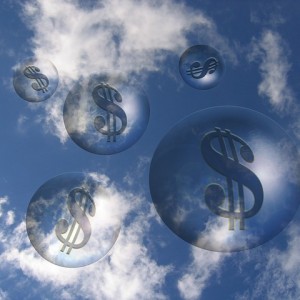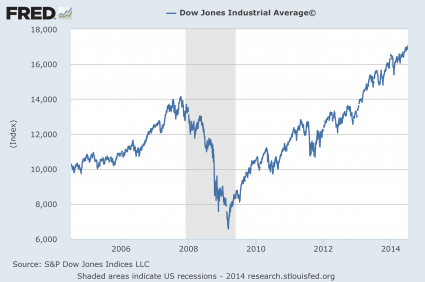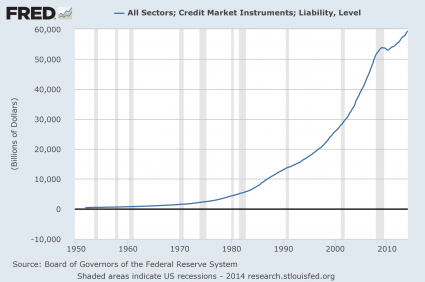 Is there any doubt that we are living in a bubble economy? At this moment in the United States we are simultaneously experiencing a stock market bubble, a government debt bubble, a corporate bond bubble, a bubble in San Francisco real estate, a farmland bubble, a derivatives bubble and a student loan debt bubble. And of course similar things could be said about most of the rest of the planet as well. In fact, the total amount of government debt around the world has risen by about 40 percent just since the last recession. But it is never sustainable when asset prices and debt levels increase much faster than the overall level of economic growth. History has shown us that all financial bubbles eventually burst. And when these current financial bubbles in America burst, the pain is going to be absolutely enormous.
Is there any doubt that we are living in a bubble economy? At this moment in the United States we are simultaneously experiencing a stock market bubble, a government debt bubble, a corporate bond bubble, a bubble in San Francisco real estate, a farmland bubble, a derivatives bubble and a student loan debt bubble. And of course similar things could be said about most of the rest of the planet as well. In fact, the total amount of government debt around the world has risen by about 40 percent just since the last recession. But it is never sustainable when asset prices and debt levels increase much faster than the overall level of economic growth. History has shown us that all financial bubbles eventually burst. And when these current financial bubbles in America burst, the pain is going to be absolutely enormous.
You know that things are getting perilous when even the New York Times starts pointing out financial bubbles everywhere. The following is a short excerpt from a recent NotQuant article…
The New York Times points out that just about everything on Earth is expensive by historical standards. And then asks the seemingly obvious question: Does that make it a bubble?
Welcome to the Everything Boom — and, quite possibly, the Everything Bubble. Around the world, nearly every asset class is expensive by historical standards. Stocks and bonds; emerging markets and advanced economies; urban office towers and Iowa farmland; you name it, and it is trading at prices that are high by historical standards relative to fundamentals. The inverse of that is relatively low returns for investors.
“Quite possibly?” We’re not sure what definition of the word “bubble” they’re using. But in our book when the price of literally everything blasts upwards, obliterating the previous ceilings of historical benchmarks, it’s a pretty good indication that you’re in a bubble.
Of course when most people think of financial bubbles the very first thing they think of is the stock market. And without a doubt we are in a stock market bubble right now. The Dow has risen more than 10,000 points since the depths of the last recession. And it is nearly 3,000 points higher than it was at the peak of the last stock market bubble in 2007 when our economy was far stronger than it is now…
But of course these stock prices do not reflect economic reality in any way whatsoever. Our economy has not even come close to recovering to the level it was at prior to the last financial crisis, and yet thanks to massive Federal Reserve money printing stock prices have soared to unprecedented heights.
At some point a massive correction is coming. No stock market bubble lasts forever. For a whole bunch of technical reasons why serious market turmoil is on the horizon, please see a recent Forbes article entitled “These 23 Charts Prove That Stocks Are Heading For A Devastating Crash“.
The bubbles in the financial markets have become so glaring that even the central bankers are starting to warn us about them. For example, just consider what the Bank for International Settlements is saying…
The Bank for International Settlements has warned that “euphoric” financial markets have become detached from the reality of a lingering post-crisis malaise, as it called for governments to ditch policies that risk stoking unsustainable asset booms.
While the global economy is struggling to escape the shadow of the crisis of 2007-09, capital markets are “extraordinarily buoyant”, the Basel-based bank said, in part because of the ultra-low monetary policy being pursued around the world. Leading central banks should not fall into the trap of raising rates “too slowly and too late”, the BIS said, calling for policy makers to halt the steady rise in debt burdens around the world and embark on reforms to boost productivity.
In its annual report, the BIS also warned of the risks brewing in emerging markets, setting out early warning indicators of possible banking crises in a number of jurisdictions, including most notably China.
“Particularly for countries in the late stages of financial booms, the trade-off is now between the risk of bringing forward the downward leg of the cycle and that of suffering a bigger bust later on,” it said.
Sadly, just like in 2007, most people are choosing not to listen to these warnings.
Another very troubling bubble that is brewing is the massive bubble of consumer credit in the United States. According to the Wall Street Journal, consumer credit in the United States increased at a 7.4 percent annual rate in May…
The Federal Reserve reported Tuesday that consumer credit—consumer loans excluding real estate debt—in May increased at an annual rate of 7.4% to a record $3.195 trillion. Most of that gain came from a 9.3% increase in nonrevolving credit, the bulk of which is accounted for by auto and student loans. Revolving credit, which is primarily credit-card debt, expanded at a more muted 2.5% rate after jumping 12.3% in May.
That might be okay if our paychecks were increasing at a 7.4% annual rate, but that is not the case at all. In fact, median household income in America has gone down for five years in a row. As the quality of our jobs goes down the drain, our paychecks are shrinking even as our bills go up. This is putting an incredible amount of stress on tens of millions of American families.
And when you look at the overall debt bubble in this country, things become even more frightening.
In a previous article, I shared a chart which shows the incredible growth of total debt in the United States. Over the past 40 years, it has gone from about 2.2 trillion dollars to nearly 60 trillion dollars…
Is this sustainable?
Of course not.
None of these financial bubbles are.
It is not a question of “if” they will burst. It is only a question of “when”.
And some believe that we are rapidly approaching that point. In fact, Marc Faber believes that we are seeing signs that it may be starting to happen already…
It’s the question investors everywhere are wrestling with: Are asset prices in a bubble, or do they simply reflect the fact that the global economy is growing once again?
For Marc Faber, editor of the Gloom, Boom & Doom Report, the answer is clear. In fact, he says the bubble may already be bursting.
“I think it’s a colossal bubble in all asset prices, and eventually it will burst, and maybe it has begun to burst already,” Faber said Tuesday on CNBC’s ‘Futures Now‘ as the S&P 500 lost ground for the second-straight session.
So what do you think?
How much time do you believe that we have before these bubbles start to burst?
Please feel free to share your thoughts by posting a comment below…

